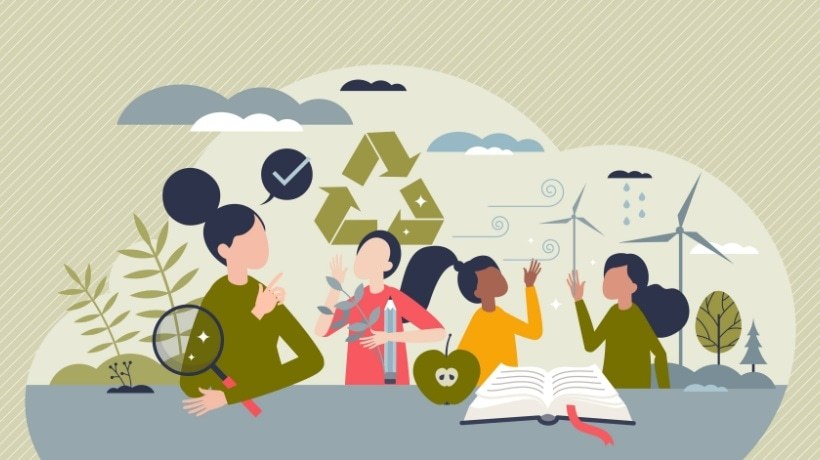How To Achieve A Green Digital Campus?
The idea of a "green digital campus" signifies a major shift in how academic institutions approach sustainability. A green digital campus uses digital technology to reduce its environmental effect, in contrast to traditional brick and mortar campuses, which frequently require substantial physical infrastructure and resources. In essence, the idea represents responsible consumption, efficiency, and conservation in the context of online learning.
Concept Of Green Digital Campus
One of the defining features of a green digital campus is its reliance on digital infrastructure and operations. Online education platforms are used as the main venues for teaching, learning, and collaboration instead of actual classrooms, lecture halls, and administrative facilities. This virtual environment significantly reduces the need for energy-intensive facilities and transportation, thereby lowering greenhouse gas emissions and resource consumption.
Furthermore, a green digital campus prioritizes sustainable practices throughout its operations. This covers the use of cloud computing, renewable energy sources, and energy-efficient data centers to power online platforms and services. By replacing print textbooks and materials with digital ones, paper consumption is decreased and deforestation is minimized. Furthermore, the carbon footprint of travel is decreased by virtual meetings, webinars, and conferences, increasing accessibility to educational opportunities while minimizing the negative environmental effects.
Beyond infrastructure and operations, the concept of a green digital campus extends to teaching and learning practices. To promote environmental responsibility and awareness among students, educators are being encouraged to integrate sustainability into their curriculum and approach. Without requiring tangible resources, virtual field trips, interactive simulations, and digital labs offer engaging and immersive learning experiences.
Sustainable Infrastructure And Operations
Institutions must give sustainable practices top priority in their daily operations and infrastructure when making the shift to a green digital campus. Through the adoption of digital technology and environmentally sustainable solutions, educational establishments can considerably diminish their environmental impact and foster sustainability.
Energy-Efficient Data Centers
Using energy-efficient data centers to host online platforms and services is one of the main components of a green digital campus. To reduce energy usage and carbon emissions, these data centers make use of renewable energy sources, optimal server architectures, and innovative cooling technologies. By optimizing energy efficiency, educational establishments can minimize the ecological consequences of their digital infrastructure while preserving dependable and safe online functions.
Cloud Computing And Virtualization
Technologies like virtualization and cloud computing are essential to attaining sustainability in online education. Institutions can minimize operating expenses, manage energy consumption, and consolidate hardware resources by moving services and apps to cloud-based platforms. By facilitating the effective distribution of computer resources and the consolidation of server architecture, virtualization further improves efficiency. This leads to less energy usage, decreased electronic waste, and increased scalability for online learning environments.
Digital Textbooks And Resources
The use of digital resources and textbooks is another essential component of sustainable infrastructure in eLearning. Digital resources are naturally more environmentally friendly than traditional print materials since they do not require the creation, printing, or distribution of paper. Institutions may lessen their carbon footprint, cut down on paper waste, and preserve natural resources by giving students access to electronic textbooks, journals, and multimedia materials. Furthermore, because they are not limited by physical materials, digital resources allow for anytime, anyplace learning. This increases accessibility and flexibility for students.
Remote Collaboration And Communication Tools
Tools for communication and remote cooperation are crucial for long-term eLearning operations. Without requiring travel or in-person meetings, universities can enable smooth communication and cooperation among students, teachers, and staff by utilizing video conferencing, messaging platforms, and collaborative software. This not only reduces transportation-related carbon emissions but also encourages accessibility and inclusion for students located far away.
Promoting Eco-Friendly Learning Practices
Encouragement of eco-friendly activities is crucial to reducing environmental effect and developing a culture of environmental responsibility among students, teachers, and stakeholders as educational institutions work to integrate sustainability into eLearning. The different approaches to incorporating sustainability into eLearning practices are listed below.
Curriculum Design And Course Content
Designing curricula and course materials is one of the main strategies to encourage environmentally responsible eLearning activities. Educators can encourage students to take action by incorporating case studies, sustainability themes, and principles into their lessons. Instructors can equip students to comprehend and tackle urgent environmental issues by incorporating subjects like environmental science, climate change, and sustainable development into the curriculum.
- Students in an environmental science course could work with a local community garden to apply sustainable farming practices. They learn about composting, crop rotation, and natural pest control, documenting the impact of these practices on crop yield and soil health over a semester.
- In a geography or environmental studies course, students could use simulation software to model the effects of climate change on different ecosystems. They experiment with variables like CO2 levels and deforestation rates to see real-time impacts on global temperatures and weather patterns.
- Engineering students could be tasked with designing a small-scale renewable energy solution for a local nonprofit organization. They explore solar, wind, and hydroelectric power options, calculating the potential energy output and cost-effectiveness of their designs, culminating in a presentation to community stakeholders.
Digital Learning Materials And Resources
Another powerful strategy for encouraging eco-friendly eLearning practices is to make use of digital learning tools and materials. Digital materials drastically lessen the amount of paper used, the cost of printing, and the environmental impact compared to traditional print textbooks and resources. Educators can give students easily accessible, current, and eco-friendly learning materials by utilizing eBooks, online articles, multimedia tools, and open educational resources (OERs). Furthermore, more flexibility and customization possibilities are provided by digital resources, enabling teachers to adapt the material to the various needs and preferences of their students.
- Utilizing interactive eBooks that include embedded videos, quizzes, and 3D models allows students to explore marine ecosystems and the impact of pollution on ocean life in a dynamic way.
- Various platforms offer free, high-quality educational content across a wide range of subjects, allowing students to access up-to-date information and resources without the need for textbooks.
- There are websites that offer free science and math simulations, allowing students to conduct virtual experiments on topics such as renewable energy sources, ecosystem dynamics, and chemical reactions without the need for physical materials.
Virtual Field Trips And Simulations
Virtual field trips and simulations reduce the environmental effect of physical travel while providing immersive and interesting learning opportunities. Using interactive simulations, Virtual Reality (VR) technology, and online tours, educators may take learners to far-off places, historical monuments, and scientific discoveries without ever having to leave the classroom. Educators can reduce the carbon impact of traditional field excursions, improve learning outcomes, and encourage experiential learning by offering virtual activities that mimic real-world surroundings and scenarios.
- Educators can use Google Earth Voyager to take students on guided tours of natural wonders, cultural landmarks, and historical sites, offering interactive stories and educational activities.
- Students can explore space through NASA's virtual tours and simulations, experiencing the surface of Mars, the International Space Station, and the Hubble space telescope's discoveries from their classroom.
- Through interactive VR experiences, students can take a virtual dive into coral reefs around the world, learning about marine biodiversity, the importance of conservation, and the impact of climate change on these ecosystems.
Online Collaboration And Group Work
Online collaboration and group work play a crucial role in promoting eco-friendly eLearning practices. Through the use of group projects, virtual conversations, and collaborative activities, instructors may help students develop a sense of community, cooperation, and information sharing. Students can interact with peers, share ideas, and work together on assignments at any time and from any location with the help of online collaboration platforms, discussion boards, and social learning networks. In addition to reducing the need for in-person meetings and travel, this encourages accessibility and inclusivity for distance learners.
- Slack channels allow students to collaborate on projects, share resources, and communicate in real time, supporting teamwork and project management skills across different time zones and locations.
- Students can use Google Docs to work simultaneously on documents, spreadsheets, and presentations, offering a platform for real-time editing, commenting, and collaboration on group assignments.
- Trello boards help student groups organize tasks, assign responsibilities, and track progress on projects, promoting effective teamwork and project management in a visually intuitive interface.
Assessment And Feedback
Assessment and feedback practices can also be aligned with eco-friendly eLearning principles. To simplify assessments and cut down on paper use, educators might make use of online tests, digital assessment tools, and automated grading systems. Teachers can promote students' learning while reducing the environmental impact of traditional paper-based examinations by using digital tools to deliver timely and constructive feedback. Incorporating peer and self-assessment feedback methods also motivates students to participate in reflective activities and take responsibility for their learning.
- There are platforms that facilitate peer assessment by allowing students to submit work and review their classmates' assignments based on criteria set by the instructor, encouraging critical thinking and collaborative learning.
- Educators can embed questions into videos, making it an interactive tool for assessing student understanding. Students engage with the video content and answer questions as they watch.
- There are tools that enable students to create digital portfolios where they can document their learning journey, receive feedback from teachers, and engage in self-assessment activities to reflect on their progress.
Conclusion
In summary, the concept of a green digital campus represents a transformative approach to sustainability in education. Educational institutions can provide high-quality eLearning experiences while minimizing their environmental impact by utilizing digital technologies and eco-friendly solutions. A green digital campus should be built on sustainable operations and infrastructure, such as digital resources and energy-efficient data centers. Additionally, educators can help students develop an awareness of and responsibility for the environment by supporting eco-friendly learning practices through curriculum design, virtual experiences, online collaboration, and assessment methodologies. Institutions can help create a more sustainable future while enabling students to take on urgent environmental concerns by incorporating sustainability into every facet of online education.
References:
- Sonetti, G., P. Lombardi, and L. Chelleri. 2016. "True green and sustainable university campuses? Toward a clusters approach." Sustainability 8 (1): 83.
- Van Weenen, H. 2000. "Towards a vision of a sustainable university." International Journal of Sustainability in Higher Education 1 (1): 20-34.
- Velazquez, L., N. Munguia, A. Platt, and J. Taddei. 2006. "Sustainable university: what can be the matter?". Journal of cleaner production 14 (9-11): 810-19.









